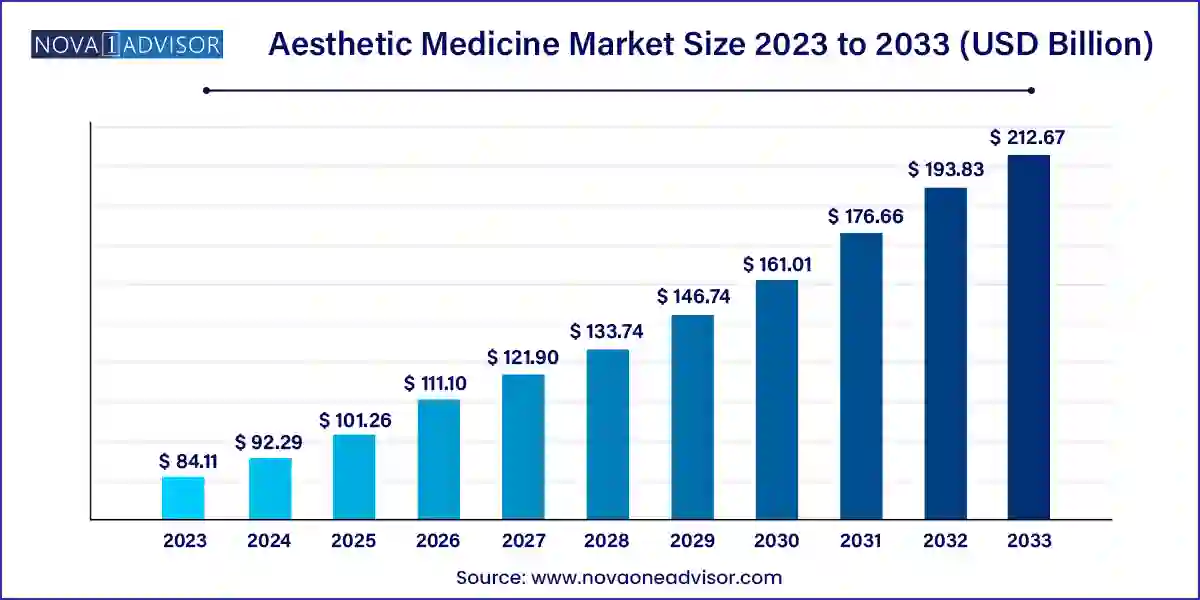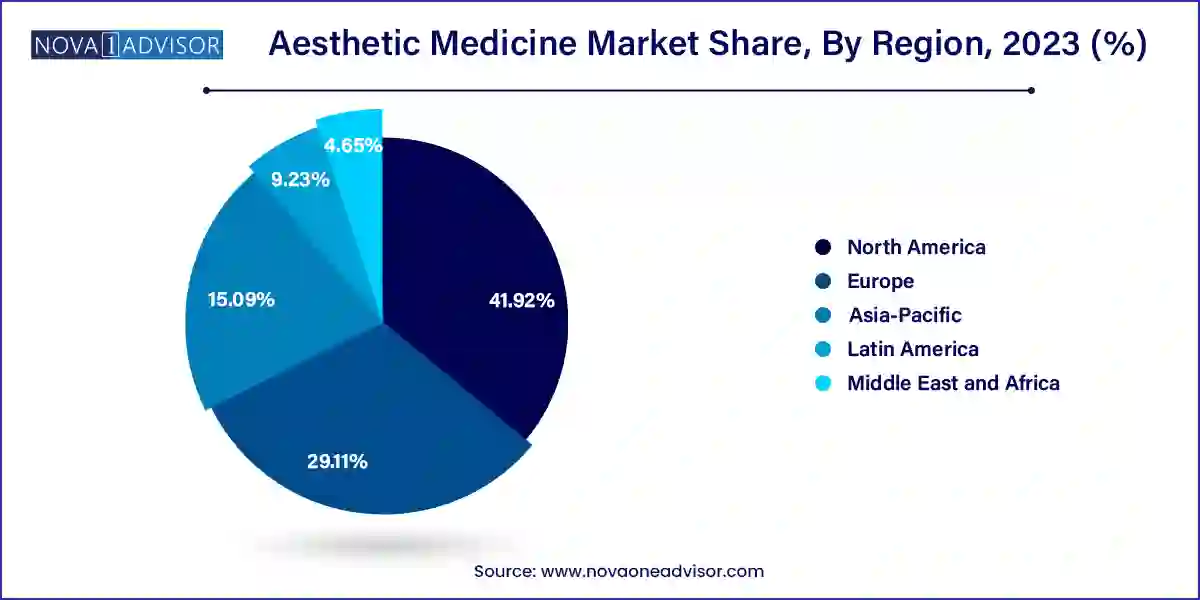Aesthetic Medicine Market Size and Growth
The global aesthetic medicine market size was valued at USD 84.11 billion in 2023 and is anticipated to reach around USD 212.67 billion by 2033, growing at a CAGR of 9.72% from 2024 to 2033.

Aesthetic Medicine Market Key Takeaways
- In 2023, North America accounted for the largest share of 41.92% of the global aesthetic medicine market revenue.
- Asia Pacific is projected to grow at the highest CAGR during the forecast period.
- The non-invasive procedures segment dominated the market with a share of 39.11% in 2023 and is expected to grow at the fastest CAGR over the forecast period.
Market Overview
The aesthetic medicine market has emerged as one of the most dynamic sectors within the global healthcare and wellness landscape. Aesthetic medicine refers to all medical procedures aimed at improving the physical appearance and satisfaction of patients using non-invasive to minimally invasive cosmetic treatments. From wrinkle-reducing injectables to body contouring surgeries, this market encapsulates a vast array of procedures and technologies.
Driven by changing beauty ideals, the rise of social media, and increasing self-awareness among both genders, the aesthetic medicine market has witnessed significant growth. Additionally, technological advancements in devices, safer procedures, and decreasing social stigma have broadened the consumer base. As per recent estimates, millions of cosmetic procedures—both surgical and non-surgical—are conducted globally each year, spanning across all age groups. The growing demand among millennials and even Gen Z indicates a cultural shift toward normalizing cosmetic enhancements.
Moreover, the convergence of dermatology, plastic surgery, and technological innovation has transformed aesthetic medicine into a personalized and accessible experience. With teleconsultation and AI-driven skin analysis platforms gaining traction, the sector is gradually moving toward smart aesthetics. Countries with strong healthcare infrastructures, such as the U.S., South Korea, Brazil, and Germany, have become hubs of both innovation and demand.
Major Trends in the Market
-
Rise of Non-Invasive and Minimally Invasive Procedures: Increasing demand for procedures like Botox, fillers, and laser treatments due to quicker recovery times and minimal discomfort.
-
Technological Innovations in Devices: Advancements in laser, RF, ultrasound, and cryolipolysis-based devices are enhancing safety and efficacy.
-
Growing Popularity of Male Aesthetic Procedures: Rising societal acceptance and targeted marketing are pushing aesthetic clinics to expand male-centric offerings.
-
Social Media Influence: Instagram and TikTok have significantly contributed to spreading awareness and acceptance of cosmetic enhancements.
-
Customization and Personalization: Demand for bespoke treatments that suit individual skin types and beauty goals is rising.
-
Medical Tourism Boom: Countries like Thailand, Mexico, and Turkey offer high-quality aesthetic services at lower costs, attracting international clientele.
-
AI and Smart Tools in Aesthetic Assessments: AI-based skin analysis and virtual try-ons are revolutionizing patient consultation and treatment planning.
Aesthetic Medicine Market Report Scope
| Report Attribute |
Details |
| Market Size in 2024 |
USD 92.29 Billion |
| Market Size by 2033 |
USD 212.67 Billion |
| Growth Rate From 2024 to 2033 |
CAGR of 9.72% |
| Base Year |
2023 |
| Forecast Period |
2024 to 2033 |
| Segments Covered |
Procedure, Product, Application, End-User, Gender, Route of Administration, Geography |
| Market Analysis (Terms Used) |
Value (US$ Million/Billion) or (Volume/Units) |
| Report Coverage |
Revenue forecast, company ranking, competitive landscape, growth factors, and trends |
| Key Companies Profiled |
AbbVie Inc., Galderma, Alma Lasers, Cynosure, Johnson & Johnson Private Limited, Lumenis Be Ltd., Solta Medical, Candela Medical, Hologic, Inc., Dentsply Sirona |
Aesthetic Medicine Market By Procedure Type Insights
Non-Invasive Procedures dominated the market in 2024, owing to their safety and convenience. Among these, Botox injections and dermal fillers continue to lead in popularity, especially for wrinkle reduction and facial volume enhancement. Soft tissue fillers, often composed of hyaluronic acid, are used for lips, cheeks, and under-eye areas. Laser hair removal and microdermabrasion also appeal to young adults, offering long-term skin rejuvenation with little downtime.
Conversely, invasive procedures such as liposuction and breast augmentation are the fastest-growing segment, especially in North America and Brazil. These treatments are gaining traction due to advances in surgical techniques and materials, offering more natural and lasting results. Liposuction, in particular, is being increasingly chosen by both men and women seeking body contouring solutions after weight loss.
Aesthetic Medicine Market By Regional Insights
North America holds the dominant share in the global aesthetic medicine market, with the United States being the epicenter. This is attributed to high consumer spending, technological innovation, a strong network of certified professionals, and increasing male participation. The U.S. alone performs millions of aesthetic procedures annually, led by Botox, breast augmentation, and laser treatments. Additionally, regulatory approvals by the FDA encourage continuous innovation and product rollouts.

Asia-Pacific is the fastest-growing region, driven by countries such as South Korea, Japan, China, and India. South Korea has earned a reputation as a cosmetic surgery capital, with people from around the world traveling for affordable and high-quality treatments. Rising disposable income, the influence of K-pop culture, and social acceptance of cosmetic enhancements are encouraging younger demographics to invest in aesthetic solutions. Local players are also innovating aggressively in the skin and facial aesthetics domain.
Recent Developments
-
In March 2025, Allergan Aesthetics (an AbbVie company) launched its new hybrid injectable for facial volume restoration in the European market, targeting natural-looking results with longer-lasting effects.
-
In February 2025, Cynosure unveiled its upgraded laser platform for skin resurfacing with integrated cooling technology, designed to improve patient comfort.
-
In January 2025, Evolus expanded its distribution of Jeuveau (botulinum toxin) to new markets across Southeast Asia and Latin America, signaling its global expansion strategy.
-
In December 2024, Merz Aesthetics partnered with top dermatology chains in India to expand the accessibility of their dermal filler products in tier-2 cities.
-
In November 2024, Cutera introduced a new RF microneedling device targeting collagen production, appealing to clinics offering skin rejuvenation services.
Aesthetic Medicine Market Top Key Companies:
- AbbVie Inc.
- Galderma
- Alma Lasers
- Cynosure
- Johnson & Johnson Private Limited
- Lumenis Be Ltd.
- Solta Medical
- Candela Medical
- Hologic, Inc.
- Dentsply Sirona
Aesthetic Medicine Market Report Segmentation
This report forecasts revenue growth at country levels and provides an analysis of the latest industry trends in each of the sub-segments from 2021 to 2033. For this study, Nova one advisor, Inc. has segmented the Aesthetic Medicine market.
By Procedure Type
- Non-Invasive Procedure
- Botox Injections
- Microdermabrasion
- Soft Tissue Fillers
- Laser Hair Removal
- Chemical Peel
- Others
- Invasive Procedure
- Liposuction
- Nose Reshaping
- Breast Augmentation
- Tummy Tuck
- Eyelid Surgery
- Others
By Product Type
- Energy-Based Devices
- Laser-based Aesthetic Device
- Radiofrequency (RF)-based Aesthetic Device
- Light-based Aesthetic Device
- Ultrasound Aesthetic Device
- Others
- Implants
- Facial Implants
- Breast Implants
- Others
- Anti-Wrinkle Products
- Botulinum Toxin
- Dermal Fillers
- Others
By Application
By End-User
- Medical Spas and Beauty Centres
- Hospitals and Clinics
- Ambulatory Surgical Centers
- Home Use
By Gender
- Males
- 18 years and below
- 19-34 years
- 35-50 years
- 51-64 years
- 65 years and above
- Females
- 18 years and below
- 19-34 years
- 35-50 years
- 51-64 years
- 65 years and above
By Route of Administration
By Region
- North America
- Europe
- Asia-Pacific
- Latin America
- Middle East & Africa (MEA)


